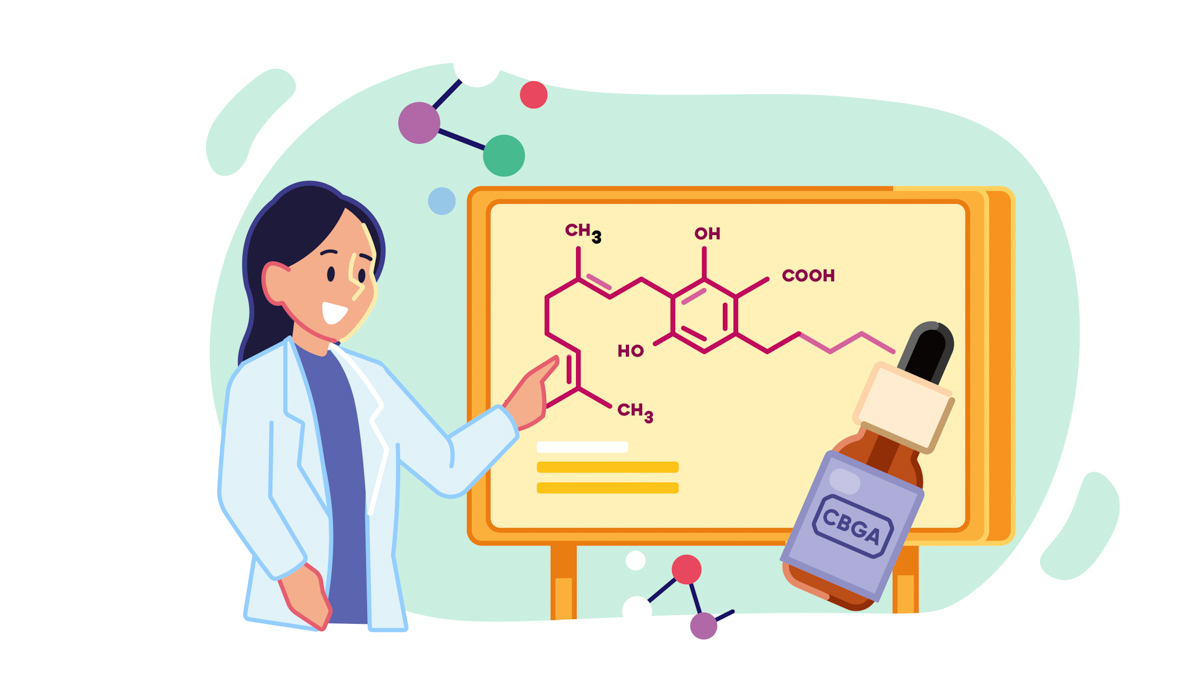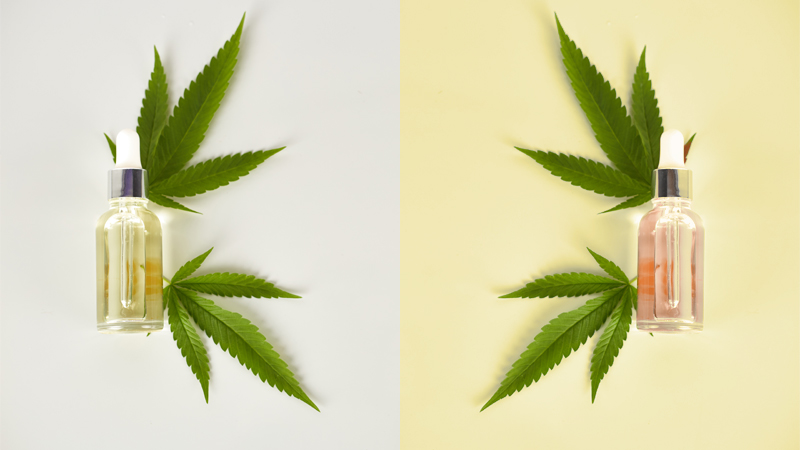What Is CBGA (Cannabigerolic Acid)?

In this article, we shed light on CBGA, also known as cannabigerolic acid. We explain its role in the cannabis plant, its relationship with other cannabinoids and terpenes, and its potential medical applications. After reading this article, you’ll learn how vital CBGA is for the plant’s therapeutic effects, and where to find CBGA products.
CBD, THC, CBG, and CBN — have one thing in common.
They all come from CBGA or cannabigerolic acid.
The cannabis plant contains at least 150 molecules classified as cannabinoids, and researchers discover new variants every few years.
These compounds work together in synergy, but since their relationship is so complex, mapping out the most beneficial ones is challenging even for modern scientists.
CBGA is an acidic precursor of CBG, the cannabinoid known for its energizing and cognitive-enhancing effects.
But CBGA plays another major role in the cannabis plant.
And you’ll learn about it from this article.
What is CBGA?

CBGA stands for cannabigerolic acid, the raw form of CBG (cannabigerol).
It’s a building block for major cannabinoids like THC, CBD, and CBC – that’s where it’s got its name “the mother of all cannabinoids”.
Before other raw cannabinoids, such as THCA, CBDA, and CBCA are formed, the cannabis plant contains high concentrations of CBGA. After this conversion, CBGA levels drop almost to zero.
CBGA doesn’t bind to CB1 receptors in your brain, so unlike THC, it won’t get you high. Studies have found that CBGA also comes with significant health benefits, with researchers pointing to its antioxidative and anticancer properties.
Cannabis strains high in CBG include Jack Herer, Animal Cookies, and Dynamite OG. To extract large quantities of CBGA, cannabis must be harvested early during its vegetative stage, before THC and CBD start to form.
How Was CBGA Discovered?
Scientists found CBG about 50 years ago. Israeli researchers first isolated the cannabinoid, but it wasn’t until the Japanese discovery 30 years later that the world heard about CBGA, its precursor.
Despite its long presence in the scientific community, little research has been conducted on its potential health benefits to date.
The majority of CBGA studies have focused on efficient ways to produce THCA for pharmaceutical and research uses. This research focused specifically on the mechanism of converting CBGA into THCA.
Recently, researchers have come up with a consistent way of extracting CBGA from a species of yeast called Pichia pastoris. In 2019, a California research team released their study on the complete synthesis of cannabinoids, including CBGA, from various yeast strains.
What Does CBGA Do?
Like all cannabinoids, CBGA produces its effects through the endocannabinoid system. Researchers have just been studying cannabinoids for the past 30 years; this short yet intense period has yielded plenty of quality papers on their therapeutic potential.
CBGA contributes to the entourage effect in cannabis. This biological phenomenon describes a unique synergy achieved by cannabinoids, terpenes, and flavonoids in the plant. Together, these compounds demonstrate 330% higher biological activity than their isolated counterparts.
When you consume CBD or THC products with trace amounts of other cannabinoids, including CBGA, their effects are stronger — and dosing becomes more predictable.
If you want to maximize your CBGA intake, you must consume raw cannabis plants in their vegetative states; by juicing them, for example.
Heating cannabis will convert CBGA into CBG, which comes with a different effect profile.
CBGA Effects: How Does It Feel?
CBGA is non-intoxicating, meaning it won’t get you high. However, that doesn’t mean it has no impact on brain function. It only means that you won’t be intoxicated after consuming it.
The effects of CBGA on the brain are mild and involve pleasant relaxation followed by anti-inflammatory actions.
Taking CBGA may lead to lower stress levels and anxiety, less frequent nausea, and reduced pain.
CBGA Health Benefits
Although CBGA hasn’t been yet extensively studied, there are several research papers indicating that it may aid patients with various conditions. It can also potentiate the health benefits of the major cannabinoids, so it’s worth adding it to your broad-spectrum CBD or marijuana routine.
Metabolic Disorders
A 2019 study that involved computer simulation examined CBGA’s role in activating peroxisome proliferator-activated receptors (PPAR) that play a major role in regulating metabolism.
When PPARs are dysfunctional, people develop diseases like diabetes and dyslipidemia (high levels of LDL cholesterol and triglycerides). The study showed that CBGA stimulated PPAR receptors, improving the metabolism of lipids and preventing excess lipid accumulation.
However, the study hasn’t yet been replicated in animal and human trials.
Colon Cancer
CBGA may one day prove an effective treatment for colorectal cancer, the third most common cancer and fourth prevalent cause of cancer-related death.
Researchers examined the cytotoxic effects of CBGA extracted from cannabis, and found that CBGA killed colon cancers while hastening early cancer cell death and stopping the cancer cell cycle.
While more studies are needed to prove CBGA’s anti-cancer potential, the researchers were encouraged by their results because CBGA could provide new avenues for preventing the transition of polyps into carcinomas.
Cardiovascular Disease
Patients with diabetes may benefit from using CBGA when it comes to some of the disease’s complications like cardiovascular disease.
In one in vitro study, CBGA greatly blocked the enzyme aldose reductase, a major trigger of the oxidative stress that causes heart disease and other problems.
The benefits of CBGA were dose-dependent, but considering its potential, it can be a safe alternative for patients who don’t respond well to synthetic inhibitor medications.
Epilepsy
Cannabinoids have the potential to succeed where conventional antiepileptic medications have failed. They’ve been the subject of intense research in these matters recently, leading to the approval of the first CBD-based drug Epidiolex.
Similar to CBD, CBGA demonstrated anticonvulsant properties in preliminary studies. Early research shows that CBGA may reduce the frequency and severity of convulsions in epileptic patients.
However, most of the evidence regarding CBGA’s antiepileptic properties comes from animal studies. Once we have more human trials on it, we’ll be able to draw definitive conclusions.
What’s the Difference Between CBGA and CBDA?

As mentioned earlier, CBGA is the precursor of all cannabinoids, and CBDA is the precursor of CBD.
Hemp plants trigger enzymatic reactions that convert CBGA to CBDA (cannabidiolic acid), CBCA (cannabichromene acid), and THCA (tetrahydrocannabinolic acid).
In simple terms, there would be no CBD, THC, CBD, and other cannabinoids without CBGA.
Although CBDA derives from CBGA, it has a different chemical structure and offers different health benefits.
Science is still exploring the therapeutic effects of non-CBD and non-THC cannabinoids. Studies have found that even a slight change in the cannabinoid profile may alter its effects on the human body.
Related: Differences Between CBG and CBD
When Does CBGA Transform Into CBG?
Since CBGA triggers the synthesis of all cannabinoids, it’s possible to convert it into active compounds like CBG.
In some cases, this process may call for using specific enzymes; other instances require simple heat application.
CBGA is easy to turn into CBG through exposure to heat, which causes CBGA to decarboxylate. As CBGA loses an additional carboxyl group from its chain, it turns to CBG.
CBG has become popular thanks to its ability to suppress the psychotropic effects of THC and enhance focus and provide energy at the same time.
That’s because CBG antagonizes CB1 receptors, unlike THC. This action means that it may also modulate marijuana addiction and other substance abuse disorders.
The energy-boosting effects of CBG stem from its adrenergic properties and its impact on serotonin receptors. Not only can CBG enhance energy and focus, but it can also prevent mood disorders and other brain problems.
CBGA FAQs
Is CBGA a cannabinoid?
Yes, CBGA is a cannabinoid. It’s an essential component of cannabis without which other cannabinoids wouldn’t be formed.
Is CBGA in CBD oil?
No. You won’t find significant amounts of CBGA in CBD oil because manufacturers decarboxylate CBDA to obtain CBD. This process also heats other acidic cannabinoids, including CBGA. If anything, you’ll find traces of CBG in full-spectrum CBD oil.
How is CBGA extracted?
Extracting CBGA from cannabis is a complex process that requires harvesting the plant in its early vegetative stage and running it through a solvent like CO2 or BHO.
Where can you find CBGA?
CBGA products are less popular than CBD oils or THC edibles, but you should be able to find some options in your local cannabis dispensary and online. The best way to deliver CBGA to your system is to juice raw cannabis in the early veg stage — this way, you can achieve high concentrations of CBGA.
Key Takeaways on CBGA
CBGA has many uses, but we’re only aware of a fraction of its health benefits. That’s because not much research has been conducted on the therapeutic qualities of CBGA and other cannabinoid acids.
CBGA not only aids the formation of other cannabinoids, but it also serves a protective, pruning role during the plant’s growth. By helping cannabis shed unnecessary leaves, CBGA transfers more energy into the buds, resulting in more resinous flowers holding higher levels of cannabinoids.
Early evidence from computer simulations and in vitro studies have demonstrated potential applications in reducing the damage from oxidative stress, supporting patients in the treatment of metabolic disorders, and eliminating cancer cells. CBGA also comes with remarkable anti-inflammatory, anti-bacterial, and mood-regulating properties.
Related Posts: